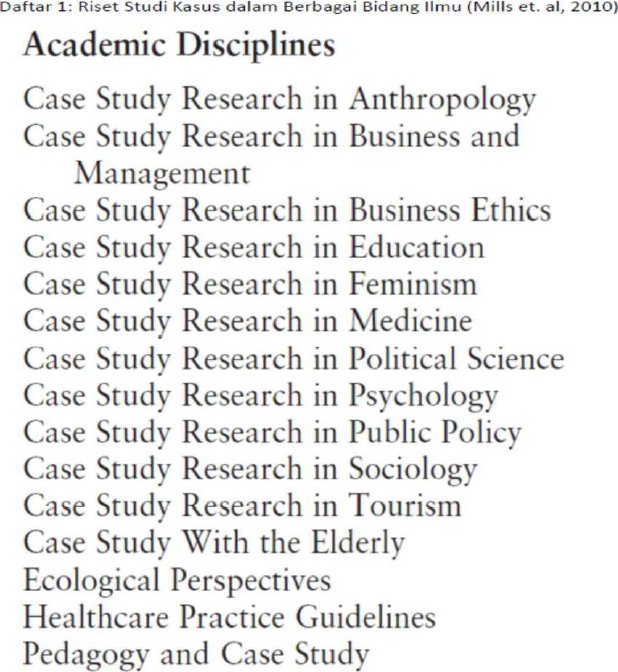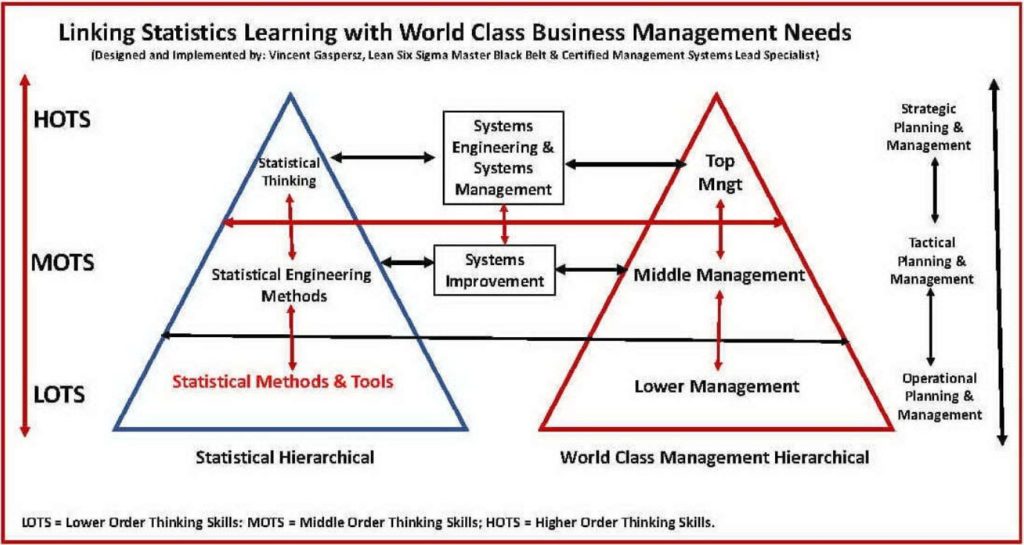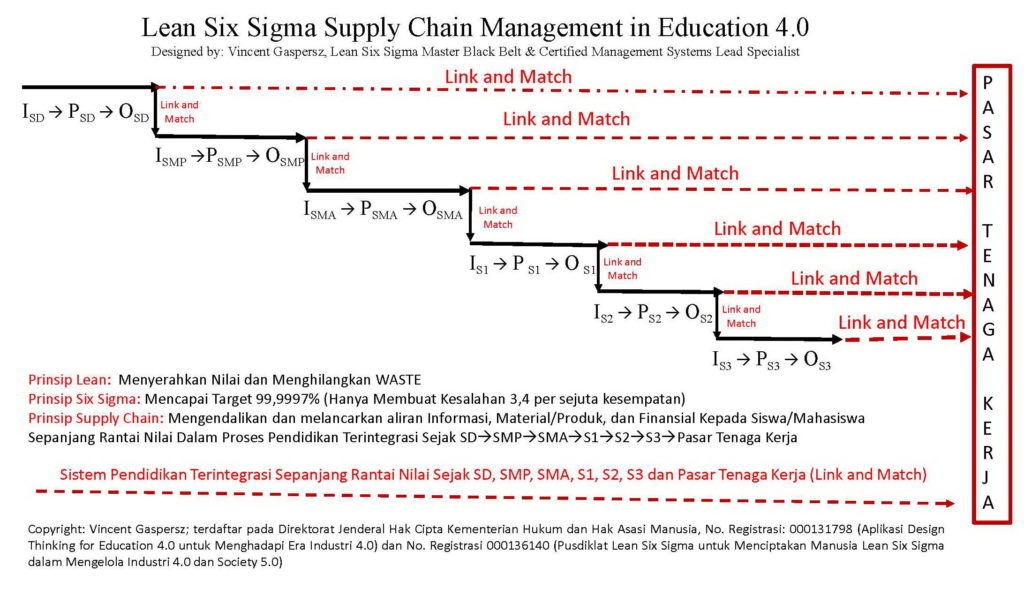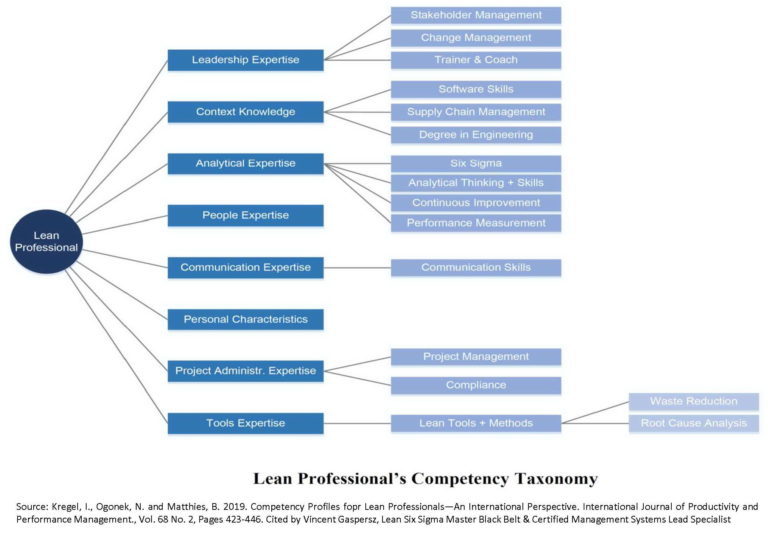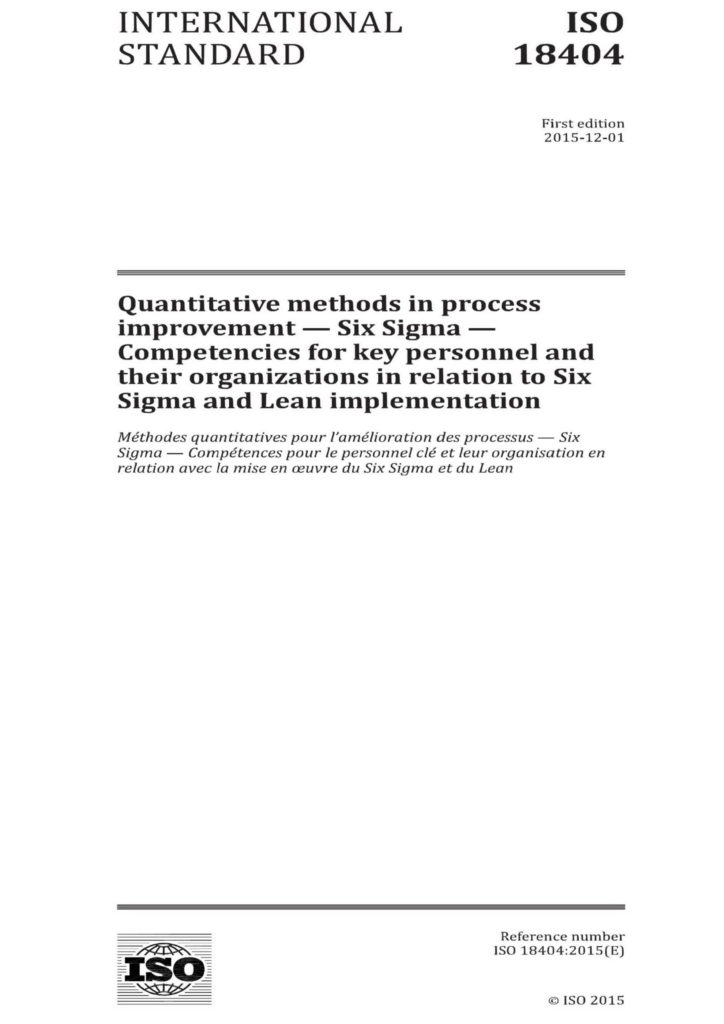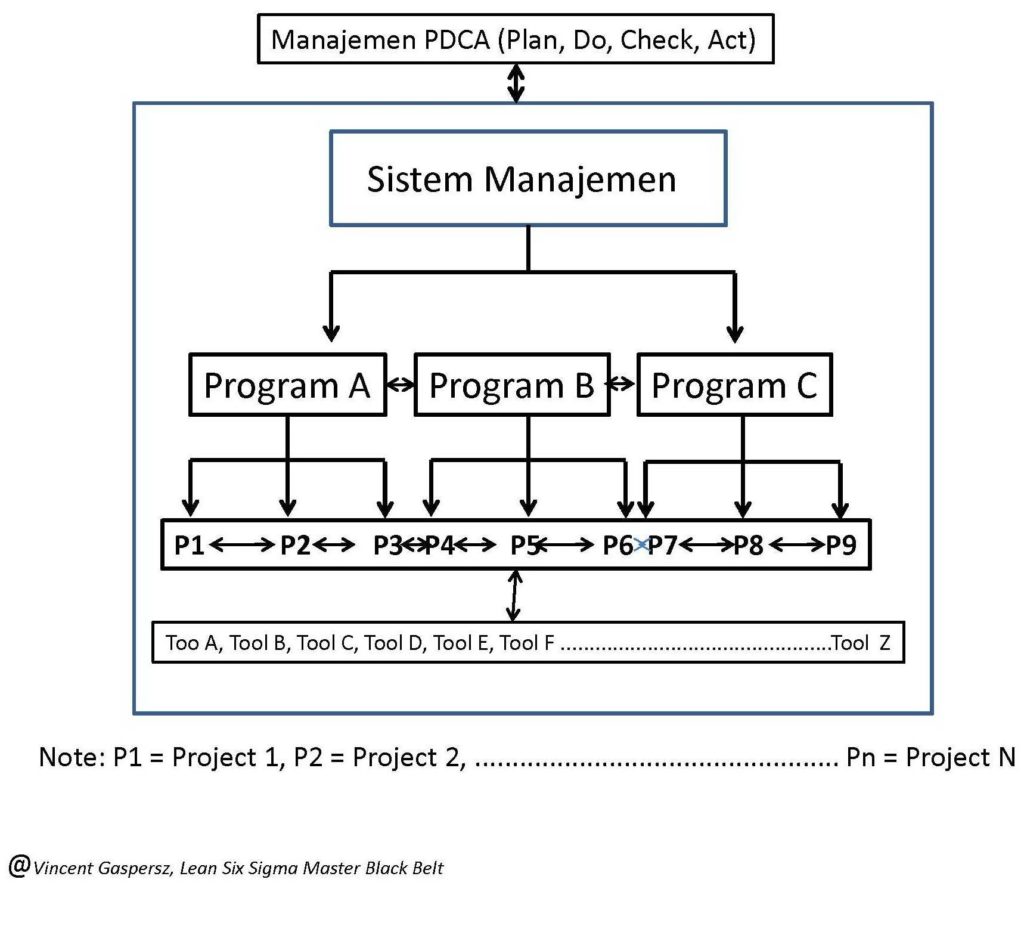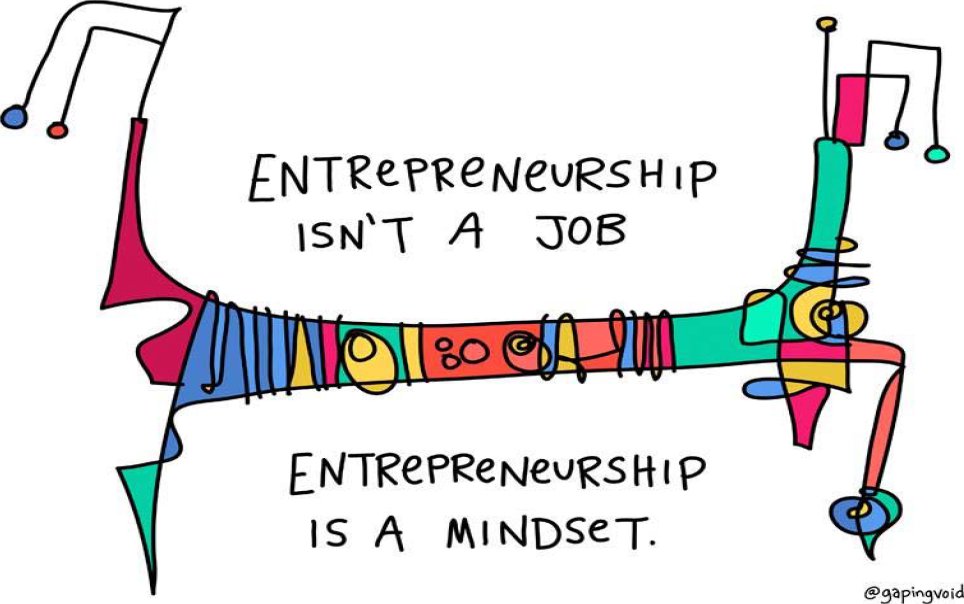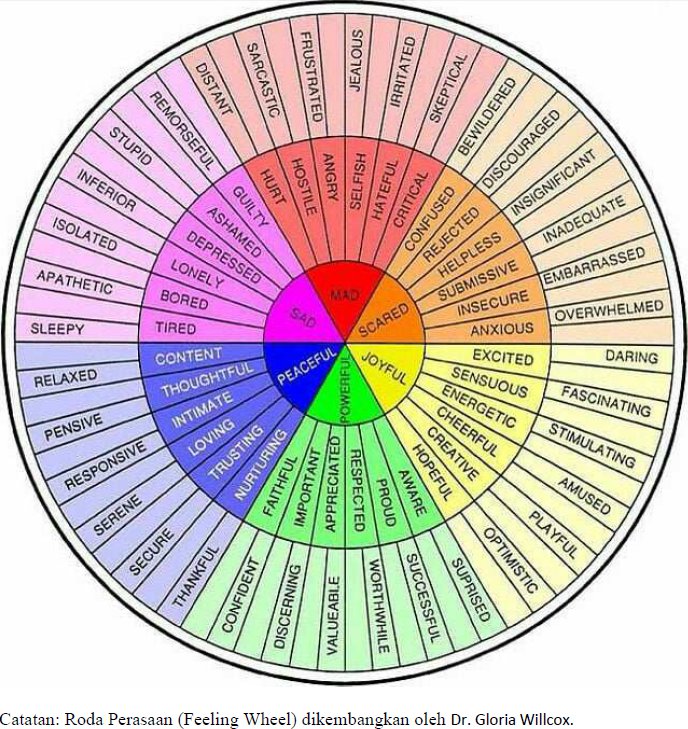-
Bahasa Indonesia
-
English
Oleh: Vincent Gaspersz,
Lean Six Sigma Master Black Belt & Certified Management System Lead Specialist
- American Production and Inventory Control Society (www.apics.org) Certified in Production and Inventory Management (CPIM), Certified Fellow in Production and Inventory Management (CFPIM) and Certified Supply Chain Professional (CSCP);
- American Society for Quality (www.asq.org) Certified Manager of Quality/Organizational Excellence (CMQ/OE), Certified Quality Engineer (CQE), Certified Quality Auditor (CQA), Certified Quality Improvement Associate (CQIA), and Certified Six Sigma Black Belt;
- International Quality Federation (www.iqf.org) Certified Six Sigma Master Black Belt (CSSMBB);
- Registration Accreditation Board (www.exemplarglobal.org) Certified Management System Auditor (CMSA), Certified Management System Practitioneer (CMSP), Certified Management System Specialist (CMSS), and Certified Management System Lead Specialist (CMSLS).
Metodologi studi kasus telah berkembang pesat sejak awal tahun 2000-an di semua bidang ilmu pengetahuan dan teknologi seiring dengan penerapan proses belajar-mengajar yang berbasis studi kasus (problem-based learning), seperti: disiplin ilmu apa saja (Duch, et. al., 2001), pendidikan dan psikologi (Levin, 2001), pendidikan tinggi (Baden, 2003), kesehatan masyarakat (Cornell and Eskin, 2003), inovasi pendidikan (Tan, 2003; Tan, 2004), kewirausahaan (Tan, 2007), matematika (Xin, 2012), industri otomotif, teknologi informasi dan komunikasi ( Lenssen, et. al., 2017), antar-disiplin ilmu (Kek and Huijser, 2017) dan berbagai bidang ilmu lain seperti ditunjukkan dalam Daftar 1 di atas (Mills et. al., 2010).
Selama ini banyak orang masih beranggapan bahwa Studi Kasus (Case Study) BUKAN metode ilmiah karena Case Study lebih banyak dilakukan berdasarkan intuisi dan ide-ide peneliti saja TANPA melakukan pengumpulan data dan analisis empirik menggunakan metode kuantitatif terutama analisis-analisis statistika. Hal itu benar jika pandangan kita masih berada sampai tahun 1980an atau 1990an. TETAPI jika kita masih berpandangan demikian sampai sekarang ini (2017), maka berarti kita tertinggal dalam hal informasi tentang ilmu pengetahuan dan teknologi tentang studi kasus. Karena perkembangan metodologi studi kasus telah berkembang pesat sejak awal tahun 2000-an. Banyak riset yang menggunakan studi kasus mengkombinasikan metode kuantitatif dan kualitatif seperti ditunjukkan dalam Tabel 1 (Hurmerinta and Nummela, 2011).

Metode studi kasus yang sekarang sering disebut sebagai Studi Kasus Generasi Kedua telah banyak melibatkan analisis-analisis kuantitatif yang kompleks seperti berpikir sistem menggunakan pemodelan sistem dinamik (Woodside, 2010), di mana proses pengumpulan data dan kajian-kajian empirik dilakukan secara mendalam terhadap suatu kasus tertentu.
Studi Kasus Generasi Kedua telah menggunakan “Logical Positivism” yaitu filosofi yang menjadi landasan utama untuk pengembangan ilmu-ilmu alamiah (natural sciences) seperti ditunjukkan dalam Bagan 1 (Piekkari and Welch, 2011).
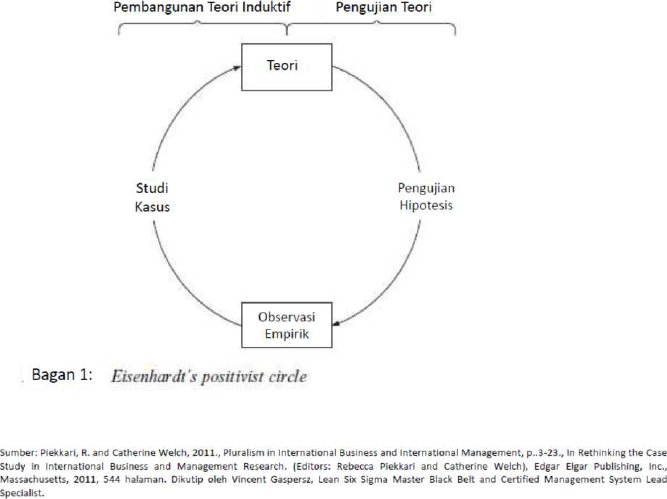
Yin (2014) mendefinisikan studi kasus sebagai pencarian empirik untuk menyelidiki fenomena kontemporer dalam konteks kehidupan nyata, terutama apabila batas antara fenomena dan konteks tidak memiliki bukti yang jelas. Sedangkan riset studi kasus (case study research = CSR) oleh Woodside (2010) mendefinisikan sebagai pencarian yang memfokuskan pada penjabaran, pemahaman, prediksi, dan/atau pengendalian individual (misal: proses, hewan, orang, rumah tangga, organisasi, kelompok, industri, kultur, atau negara).
Studi kasus dalam praktek nyata terutama dipergunakan untuk membangun teori baru dan/atau menguji teori yang telah ada (Buck, 2011) sebagai berikut:
- Studi kasus digunakan secara induktif pada tahap awal pembangunan teori sebagai alat eksplorasi untuk memperoleh data empirik yang memungkinkan kita untuk memberikan saran bagi generalisasi hubungan kausal atau hipotesis. Contoh dalam proses induktif ini seperti menyarankan hipotesis baru, penambahan variabel-variabel baru pada teori yang telah ada, atau merupakan sintesis (perpaduan) dari beberapa teori yang berbeda. Dalam konteks ini generalisasi dapat dilakukan pada pengujian empirik. Studi kasus untuk pembangunan teori baru ditunjukkan dalam Bagan 2 (Dul and Hak, 2008).

- Studi kasus dapat juga digunakan untuk menguji teori-teori yang telah ada yang diturunkan secara induktif atau deduktif. Dalam konteks ini, teori-teori umum yang menunjukkan hubungan kausal dapat dibandingkan dengan realitas empirik, dan teori yang dikembangkan terdahulu dapat dipergunakan sebagai “template” untuk membandingkan hasil-hasil empirik dari studi kasus itu. Studi kasus untuk keperluan praktek nomor 2 ini ditunjukkan dalam Bagan 3 (Dul and Hak, 2008).
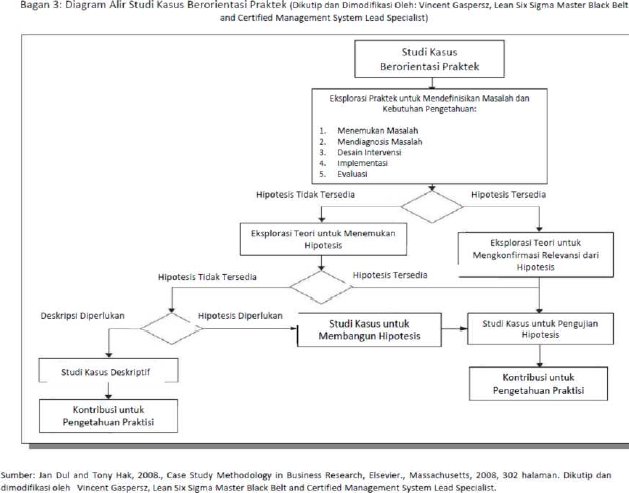
Dalam praktek nyata seringkali studi kasus melibatkan banyak hipotesis menggunakan analisis-analisis kuantitatif yang kompleks (Dubey et. al., 2017), menggunakan pemikiran sistem dan pemodelan sistem dinamik seperti kasus industri pariwisata Golf yang ditunjukkan dalam Bagan 4, Tabel 2 dan Tabel 3 (Woodside, 2010).
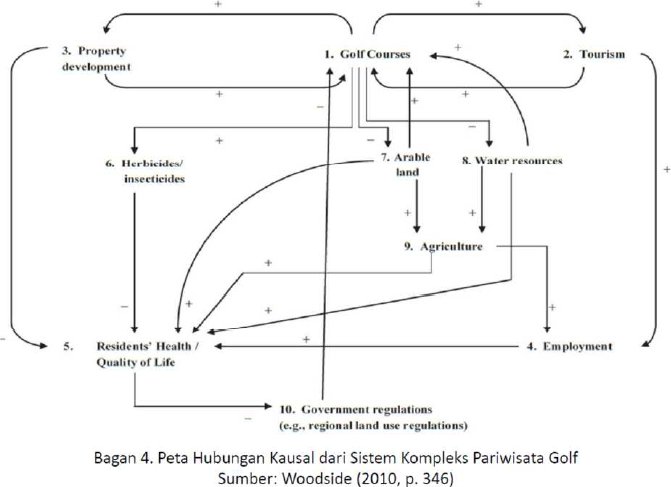

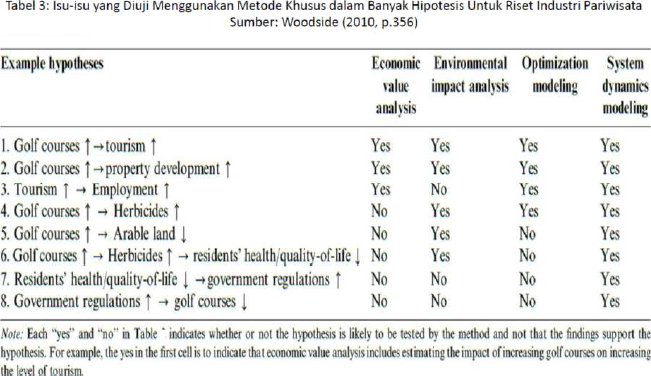
Banyak contoh riset studi kasus dapat dilakukan dalam konteks perusahaan industri seperti dikemukakan dalam Bagan 5 (Brannen, 2011), di mana proses penarikan contoh kasus dapat menggunakan metode penarikan contoh multilevel seperti ditunjukkan dalam Bagan 6 (Fletcher and Plakoyiannaki, 2011). Hasil-hasil riset studi kasus telah dipublikasikan dalam jurnal-jurnal internasional seperti ditunjukkan dalam Tabel 4 (Dul and Hak, 2011).

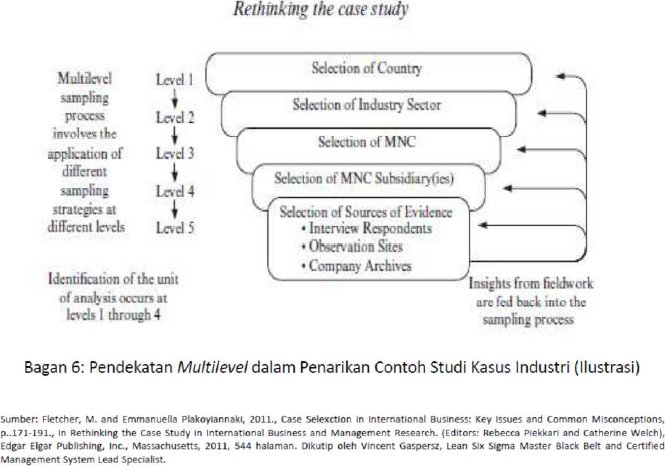
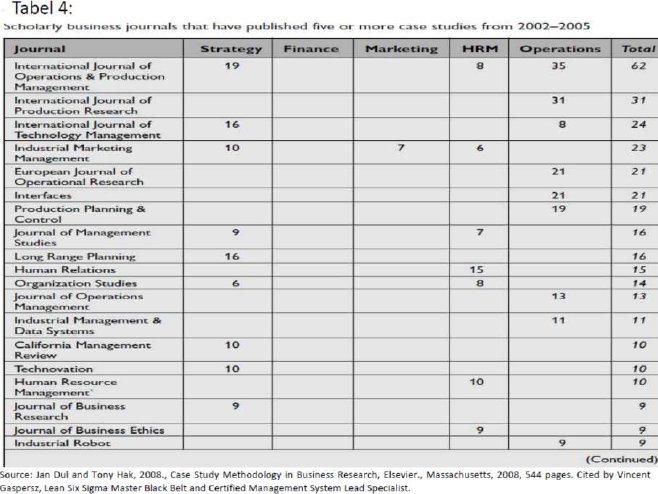
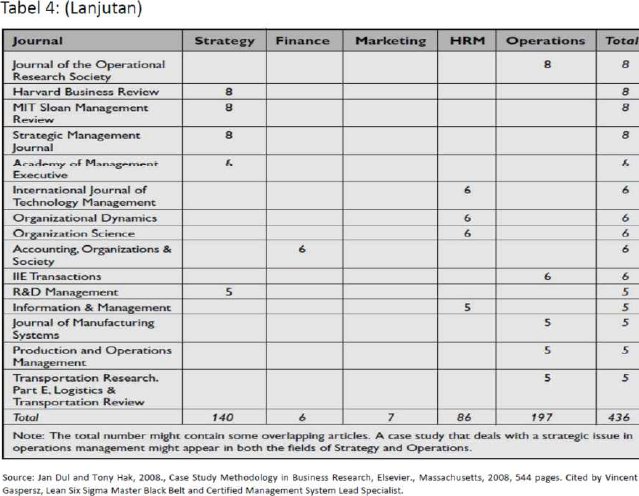
Format Penulisan Studi Kasus (Case Study Report)
Tidak ada format baku dalam penulisan studi kasus, tetapi saran dari Dul and Hak (2008, p. 276-277) dalam buku Case Study Methodology in Business Research berikut dapat diikuti.
- Judul:
Pada intinya bagian judul memuat ringkasan dari studi kasus, sehingga memuat topik studi kasus, deskripsi singkat dari topik dan tujuan riset, termasuk strategi riset, sebagai misal mencantumkan bahwa riset ini “menggunakan” studi kasus tunggal. - Pendahuluan:
Pada bagian pendahuluan ini memuat hasil-hasil dari tahap persiapan riset (preparation phase of the research), yang terdiri dari: topik riset, tujuan riset secara umum (hasil dari orientasi), body of knowledge (BoK) berkaitan dengan topik riset (hasil dari eksplorasi), dan tujuan riset secara spesifik. - Metode:
Pada bagian metode dicantumkan bagaimana pelaksanaan riset itu menggunakan metodologi studi kasus. Hal ini berkaitan dengan strategi riset (deskripsi dan justifikasi dari strategi riset), tujuan riset spesifik yang berkaitan, calon studi kasus (deskripsi dan justifikasi calon studi kasus) dari mana studi kasus itu dipilih, seleksi studi kasus (deskripsi dan justifikasi pemilihan studi kasus dari calon-calon studi kasus), pengukuran (deskripsi tentang bagaimana variabel-variabel itu didefinisikan, bagaimana obyek pengukuran ditetapkan, bagimana sumber-sumber data diidentifikasi, dipilih, dan diakses, serta bagaimana data itu diekstrak dari sumber-sumber ini, bagaimana data dicatat, serta bagaimana data ditangani), analisis data (deskripsi dan justifikasi dari teknik-teknik analisis kualitatif dan/atau kuantitatif). - Hasil-hasil:
Pada bagian hasil mencantumkan hasil-hasil dari riset studi kasus, interpretasi dan diskusi, ringkasan hasil-hasil pengukuran, hasil-hasil dari analisis data berkaitan dengan tujuan riset spesifik. - Diskusi
Pada bagian diskusi mencantumkan implikasi dari hasil-hasil studi kasus termasuk mencantumkan keterbatasan dari studi kasus, implikasi hasil-hasil studi kasus pada teori (untuk studi kasus berorientasi teori) atau untuk praktek (untuk studi kasus berorientasi praktek), riset mendatang yang diperlukan berdasarkan hasil dari studi kasus (untuk studi kasus berorientasi teori, juga replikasi strategi), serta mencantumkan kontribusi hasil studi kasus pada praktek (untuk studi kasus berorientasi praktek).
Jika memperhatikan format studi kasus baik untuk studi kasus berorientasi teori atau berorientasi praktek, maka secara garis besar penulisan studi kasus adalah serupa dengan penulisan penelitian survei (survey research report) maupun penulisan penelitian eksperimental (experimental research report). Dengan demikian tidak ada lagi alasan yang menyatakan bahwa studi kasus lebih mudah daripada penelitian survei dan/atau penelitian eksperimental. Malahan studi kasus mengkaji secara mendalam suatu obyek tertentu sehingga akan lebih cocok bagi praktisi/mahasiswa/dosen manajemen bisnis dan industri.
Referensi:
- Baden, M. S., 2003, Facilitating Problem-based Learning: Illuminating Perspectives, The Society for Research into Higher Education (SRHE) and Open University Press, Berkshire, England, 170 pages.
- Brannen, M. Y, 2011., Using Multiple Case Studies to Generalize from Ethnographic Research, p..124-145., In Rethinking the Case Study in International Business and Management Research. (Editors: Rebecca Piekkari and Catherine Welch), Edgar Elgar Publishing, Inc., Massachusetts, 2011, 544 pages.
- Buck, T. 2011., Case Selection Informed by Theory, p. 192-209, in Rethinking the Case Study in International Business and Management Research. (Editors: Rebecca Piekkari and Catherine Welch), Edgar Elgar Publishing, Inc., Massachusetts, 2011, 544 pages.
- Cornell, J. And Frada Eskin, 2003., Problem-based Learning for Health Improvement: Practical Public Health for Every Professional, CRC Press, Florida, 242 pages.
- Dubey, U., D.P. Kothari, and G. K. Awari, 2017, Quantitative Techniques in Business, Management, and Finance: A Case Study Approach, CRC Press, Florida, 503 pages.
- Duch, B. J., Susan E. Groh, and Deborah E. Allen, 2001., The Power of Problem-based Learning: A Practical “How To” for Teaching Undergraduate Courses in Any Discipline, Stylus Publishing, Virginia, 285 pages.
- Dul, J and Tony Hak, 2008., Case Study Methodology in Business Research, Elsevier., Massachusetts, 2008, 302 pages.
- Fletcher, M. and Emmanuella Plakoyiannaki, 2011., Case Selection in International Business: Key Issues and Common Misconceptions, p..171-191., In Rethinking the Case Study in International Business and Management Research. (Editors: Rebecca Piekkari and Catherine Welch), Edgar Elgar Publishing, Inc., Massachusetts, 2011, 544 pages.
- Hurmerinta, L. and Niina Nummela, 2011., Mixed-Method Case Studies in International Business Research, p..210-228., In Rethinking the Case Study in International Business and Management Research. (Editors: Rebecca Piekkari and Catherine Welch), Edgar Elgar Publishing, Inc., Massachusetts, 2011, 544 pages.
- Kek, M. Y. C. A. and Henk Huijser, 2017., Problem-based Learning into the Future: Imagining and Agile PBL Ecology for Learning, Springer, Singapore, 204 pages.
- Lenssen, G., Jay Hyuk Rhee, and Fabien Martinez, 2017., The Role of Corporate Sustainability in Asian Development: A Case Study Handbook in the Automotive and ICT Industries, Springer International Publishing, Switzerland, 168 pages.
- Levin, B. B, 2001., Energizing Teacher Education and Professional Development with Problem-based Learning, Association for Supervision and Curriculum Development, Virginia, 149 pages.
- Mills, A. J, Gabriella Eurepos, and EldenWrebe., 2010, Encyclopedia of Case Study Research, Vol. 1, Sage, Los Angeles, 1.109 pages.
- Piekkari, R. and Catherine Welch, 2011., Pluralism in International Business and International Management, p..3-23., In Rethinking the Case Study in International Business and Management Research. (Editors: Rebecca Piekkari and Catherine Welch), Edgar Elgar Publishing, Inc., Massachusetts, 2011, 544 pages.
- Tan, Oon-Seng., 2003, Problem-based Learning Innovation: Using Problems to Power Learning in the 21st Century, Gale Cengage Learning, Singapore, 166 pages.
- Tan, Oon-Seng., 2004., Enhancing Thinking Through Problem-based Learning Approaches: International Perspectives, Cengage Learning, Singapore, 218 pages.
- Tan, Oon-Seng., 2007., Problem-based Learning and Creativity, Cengage Learning Asia, Singapore, 256 pages.
- Xin, Yan Ping., 2012., Conceptual Model-based Problem Solving (COMPS): Teach Students with Learning Difficulties to Solve Math Problems, Rotterdam, 267 pages.
- Yin, R. K., 2014., Case Study Research Design and Methods, 5th ed., Thousand Oaks, California, 282 pages.
- Woodside, A. G., 2010., Case Study Research: Theory, Methods, Practice., Emerald Group Publishing, UK., 454 pages.
Case Study Methodology for Practitioners/Students/Lecturers of Business and Industrial Management
By: Vincent Gaspersz,
Lean Six Sigma Master Black Belt & Certified Management System Lead Specialist
- American Production and Inventory Control Society (www.apics.org) Certified in Production and Inventory Management (CPIM), Certified Fellow in Production and Inventory Management (CFPIM) and Certified Supply Chain Professional (CSCP);
- American Society for Quality (www.asq.org) Certified Manager of Quality/Organizational Excellence (CMQ/OE), Certified Quality Engineer (CQE), Certified Quality Auditor (CQA), Certified Quality Improvement Associate (CQIA), and Certified Six Sigma Black Belt;
- International Quality Federation (www.iqf.org) Certified Six Sigma Master Black Belt (CSSMBB);
- Registration Accreditation Board (www.exemplarglobal.org) Certified Management System Auditor (CMSA), Certified Management System Practitioneer (CMSP), Certified Management System Specialist (CMSS), and Certified Management System Lead Specialist (CMSLS).
The case study methodology has grown tremendously since the early 2000s in all areas of science and technology along with the application of teaching and learning process based on case studies (problem-based learning), such as: any discipline (Duch, et al. , 2001), educational and psychology (Levin, 2001), higher education (Baden, 2003), public health (Cornell and Eskin, 2003), educational innovation (Tan, 2003; Tan, 2004), entrepreneurship (Tan, 2007) mathematics (Xin, 2012), automotive and information communication technology industries (Lenssen, et al., 2017), interdisciplinary (Kek and Huijser, 2017) and various other disciplines as indicated in List 1 above (Mills et al., 2010).
All this time many people still assume that Case Study is NOT a scientific method because Case Study is more done based on the researchers’ intuitions and ideas alone WITHOUT performing data collection and empirical analysis using quantitative methods, especially statistical analyses. This is true if our view is still in the 1980s or 1990s. BUT if we still hold that view until now (2017), then we are left behind in term of science and technology information about about case studies because the development of case study methodology has grown rapidly since the early 2000s. Many research using case studies combine quantitative and qualitative methods as shown in Table 1 (Hurmerinta and Nummela, 2011).

The current case study method, that is often referred to as the Second Generation Case Study, has largely involved complex quantitative analyses such as system thinking using dynamic system modeling (Woodside, 2010), where the processes of data collection and empirical studies are conducted in depth on a specific case.
The Second Generation Case Study has been using “Logical Positivism”, which is the philosophy that becomes the main foundation for the development of natural sciences as shown in Chart 1 (Piekkari and Welch, 2011).

Yin (2014) defines case study as an empirical search to investigate contemporary phenomenon in real-life context, especially if the boundary between phenomenon and context has no clear evidence. Whereas case study research (CSR) by Woodside (2010) is defined as a search focusing on the description, understanding, prediction, and/or individual control (e.g. processes, animals, people, households, organizations, groups, industries, cultures, or countries).
Case studies in real practices are primarily used to build new theories and/or to test existing theories (Buck, 2011) as follows:
- Case study is inductively used in the early stage of theoretical development as an exploration tool for obtaining empirical data that allows us to provide suggestions for the generalization of causal relationships or hypotheses. Examples in this inductive process include suggesting new hypotheses, adding new variables to existing theories, or synthesis of several different theories. In this context, generalization can be performed on empirical testing. Case study for the development of new theories is shown in Chart 2 (Dul and Hak, 2008).

- Case studies can also be used to test existing theories that are brought down inductively or deductively. In this context, general theories that show causal relationships can be compared with empirical reality, and the earlier developed theory can be used as a “template” to compare the empirical results of that case study. This case study for practical needs is shown in Chart 3 (Dul and Hak, 2008).

In real practice, case studies involve many hypotheses using complex quantitative analyses (Dubey et al., 2017), using system thinking and dynamic system modeling such as a golf tourism industry case as shown in Chart 4, Table 2 and Table 3 (Woodside, 2010).



Many examples of case study research can be undertaken in the context of industrial companies as outlined in Chart 5 (Brannen, 2011), where the case sampling process can use multilevel sampling method as shown in Chart 6 (Fletcher and Plakoyiannaki, 2011). The research results of case studies have been published in international journals as shown in Table 4 (Dul and Hak, 2011).




Writing Format of Case Study (Case Study Report)
There is no standard format in case study writing, but the following suggestions from Dul and Hak (2008, pp. 276-277) in Case Study Methodology in Business Research book can be followed.
- Title:
In essence the title contains a summary of the case study; thus it covers the topic of case study, a brief description of the topic and research objective, including research strategy; for example stating that this research “uses” a single case study. - Introduction:
This introduction section covers the results of the research preparation phase, consisting of: research topic, general research objective (results of orientation), body of knowledge (BoK) related to research topic (results of exploration), and specific research objective. - Method:
The method section describes how that research implementation uses the case study methodology. This relates to research strategy (description and justification of research strategy), specific research related objective, case study candidates (description and justification of case study candidates) of from where that case study is chosen, case study selection (description and justification of case study selection from the case study candidates), measurement (description of how those variables are defined, how the measuring objects are set, how the data sources are identified, selected, and accessed, and how those data is extracted from these sources, how data are recorded, as well as how data are handled), data analysis (description and justification of qualitative and/or quantitative analysis techniques). - Results:
The results section lists the results of case study research, interpretation and discussion, summaries of measurement results and results of data analysis related to specific research objective. - Discussion
In the discussion section lists the implication of the case study results, including the limitations of the case study, the implication of case study results on theory (for theory-oriented case study) or to practice (for practice-oriented case study), future research needed based on the of case study (for theory-oriented case study, also includes strategy replication), as well as the listed contribution of case study results to practice (for practice oriented case studies).
When considering the case study format for either theory-oriented or practice-oriented case study, then in general, case study writing is largely similar to the writing of survey research report or experimental research reports. Therefore, there is no excuse to argue that case studies are easier than research surveys and/or experimental studies. In fact, case study examines in depth a particular object so that it would be more suitable for practitioners/students/lecturers of business and industry.
References:
- Baden, M. S., 2003, Facilitating Problem-based Learning: Illuminating Perspectives, The Society for Research into Higher Education (SRHE) and Open University Press, Berkshire, England, 170 pages.
- Brannen, M. Y, 2011., Using Multiple Case Studies to Generalize from Ethnographic Research, p..124-145., In Rethinking the Case Study in International Business and Management Research. (Editors: Rebecca Piekkari and Catherine Welch), Edgar Elgar Publishing, Inc., Massachusetts, 2011, 544 pages.
- Buck, T. 2011., Case Selection Informed by Theory, p. 192-209, in Rethinking the Case Study in International Business and Management Research. (Editors: Rebecca Piekkari and Catherine Welch), Edgar Elgar Publishing, Inc., Massachusetts, 2011, 544 pages.
- Cornell, J. And Frada Eskin, 2003., Problem-based Learning for Health Improvement: Practical Public Health for Every Professional, CRC Press, Florida, 242 pages.
- Dubey, U., D.P. Kothari, and G. K. Awari, 2017, Quantitative Techniques in Business, Management, and Finance: A Case Study Approach, CRC Press, Florida, 503 pages.
- Duch, B. J., Susan E. Groh, and Deborah E. Allen, 2001., The Power of Problem-based Learning: A Practical “How To” for Teaching Undergraduate Courses in Any Discipline, Stylus Publishing, Virginia, 285 pages.
- Dul, J and Tony Hak, 2008., Case Study Methodology in Business Research, Elsevier., Massachusetts, 2008, 302 pages.
- Fletcher, M. and Emmanuella Plakoyiannaki, 2011., Case Selection in International Business: Key Issues and Common Misconceptions, p..171-191., In Rethinking the Case Study in International Business and Management Research. (Editors: Rebecca Piekkari and Catherine Welch), Edgar Elgar Publishing, Inc., Massachusetts, 2011, 544 pages.
- Hurmerinta, L. and Niina Nummela, 2011., Mixed-Method Case Studies in International Business Research, p..210-228., In Rethinking the Case Study in International Business and Management Research. (Editors: Rebecca Piekkari and Catherine Welch), Edgar Elgar Publishing, Inc., Massachusetts, 2011, 544 pages.
- Kek, M. Y. C. A. and Henk Huijser, 2017., Problem-based Learning into the Future: Imagining and Agile PBL Ecology for Learning, Springer, Singapore, 204 pages.
- Lenssen, G., Jay Hyuk Rhee, and Fabien Martinez, 2017., The Role of Corporate Sustainability in Asian Development: A Case Study Handbook in the Automotive and ICT Industries, Springer International Publishing, Switzerland, 168 pages.
- Levin, B. B, 2001., Energizing Teacher Education and Professional Development with Problem-based Learning, Association for Supervision and Curriculum Development, Virginia, 149 pages.
- Mills, A. J, Gabriella Eurepos, and EldenWrebe., 2010, Encyclopedia of Case Study Research, Vol. 1, Sage, Los Angeles, 1.109 pages.
- Piekkari, R. and Catherine Welch, 2011., Pluralism in International Business and International Management, p..3-23., In Rethinking the Case Study in International Business and Management Research. (Editors: Rebecca Piekkari and Catherine Welch), Edgar Elgar Publishing, Inc., Massachusetts, 2011, 544 pages.
- Tan, Oon-Seng., 2003, Problem-based Learning Innovation: Using Problems to Power Learning in the 21st Century, Gale Cengage Learning, Singapore, 166 pages.
- Tan, Oon-Seng., 2004., Enhancing Thinking Through Problem-based Learning Approaches: International Perspectives, Cengage Learning, Singapore, 218 pages.
- Tan, Oon-Seng., 2007., Problem-based Learning and Creativity, Cengage Learning Asia, Singapore, 256 pages.
- Xin, Yan Ping., 2012., Conceptual Model-based Problem Solving (COMPS): Teach Students with Learning Difficulties to Solve Math Problems, Rotterdam, 267 pages.
- Yin, R. K., 2014., Case Study Research Design and Methods, 5th ed., Thousand Oaks, California, 282 pages.
- Woodside, A. G., 2010., Case Study Research: Theory, Methods, Practice., Emerald Group Publishing, UK., 454 pages.
